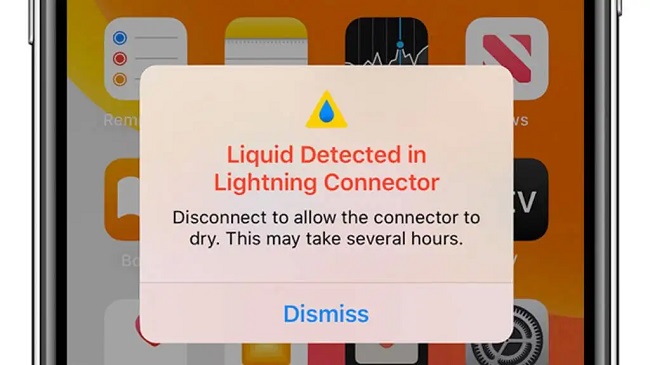While the iPhone X and later models have improved water resistance over previous generations, they are not really “waterproof.” The iPhone’s Liquid Contact Indicator (LCI) is triggered by as little as a single drop of water.
The SIM tray indication light goes here. The LCI is often a colourless metallic sheen. Its red colour is caused by its reaction to water. Checking the LCI colour after removing the SIM tray confirms liquid detection.
Liquid Detected In Lightning Connector or Charging Unavailable is the message displayed on the iPhone when LCI is activated. When you connect the lighting cable, you always get the same error.

What Not to Do If Your iPhone Sound an Alert for Liquid?
The water droplets can be pushed further, as reported by Apple Support Service, if you place your iPhone in a bowl of rice, dry it with a blow dryer or compressed air, and insert something alien into the lightning port.
Read Also:
Consequently, the potential for harm is raised. In addition, the iPhone can overheat if exposed to an external heat source, which can impair performance, lead to data corruption, and even pose a safety issue due to leaking batteries.
What Should I Do If My iPhone Keeps Sending Me Warnings About Moisture?
So now that you know what not to do, let’s get into the specifics of how to get the water out of your charging port.
Take Off Your Case And Turn Off Your iPhone
The moment you take your iPhone out of the water, you should power it down and take it out of its cover. There may be water lurking beneath the case, ready to seep into the delicate inner workings. Turn off your iPhone as well. Using it when it’s damp increases the risk of injury.
Take Out The Plugs
Disconnect the lightning cord, hands-free, and any other extras now that the phone is turned off. Also, remember to remove your SIM card. The SIM card and other components shouldn’t be reinserted until they’ve dried completely.
Make sure the iPhone’s charging is turned off. Connecting to any source of electricity is risky if there is water in the charging port or on the circuit board.
iPhone, please dry
Once you’ve disconnected your iPhone’s attachments, you can soak it in water using a towel or tissue paper. This seals off the screen layers, buttons, and circuit board from further water damage. However, you shouldn’t risk inserting a cloth inside the port.
Softly Tap Your Palm
To remove moisture from the iPhone’s lightning port, tap the device lightly on your palm with the port pointing down. The water is pushed downward and out of the port as a result. Apple’s technical support team suggests this method because they believe it to be the most secure and effective.
Swap Out Your Lightning Cable
If your iPhone still displays the liquid detection error after drying out the lightning port, the problem may lie with the cable connecting the two devices. A hardware issue is possible. The cable might also deteriorate if it gets wet.
When water gets between the pins of the charging cable, the iPhone displays a “Charging Not Available” message. If you’re having trouble diagnosing the source of the issue, switching charging cables may help.
If your iPhone only charges with a different cable, the original cord is likely faulty. If you want to get the most out of your Apple product, you should stick with official Apple accessories.
Read Also:
- Is the Apple Watch Series 3 Waterproof
- How To Make Cloud in Little Alchemy 2
- How To Make Sky in Little Alchemy
Keep in a cool, dry place for 24 hours
If trying another cable didn’t help, the issue is very definitely the lightning port. The iPhone will continue to give a pop-up warning if liquid is detected in the port, even if you dry the port.
Due to its extreme sensitivity, an iPhone will not allow charging for at least a few hours. Your iPhone will benefit from being left in a cool, dry place for a day. Attempts can be made at various points to gauge success.



















